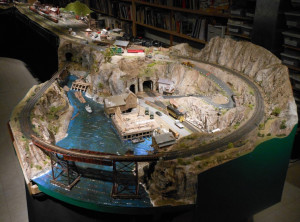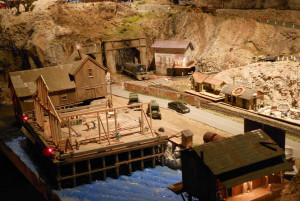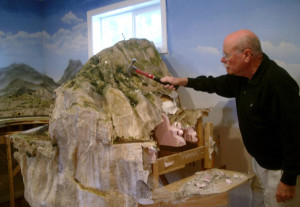Rich Thom / Photos by Dick Haines
Twenty-seven regulars gathered at the Summerhill Residence in Oak Harbor for the December meeting of the Skagit Valley & Whidbey NMRA Clinic. Four from the Mt. Vernon NMRA clinic group made the long journey from the mainland, and Barry Anderson braved the sparse wintertime ferry service to come over from Port Townsend. Clinic Chair Rich Blake welcomed two guests this evening, Mike Garcia, Coupeville and Mike Piccone, Oak Harbor.
In opening remarks Rich observed that Performance R/C Hobbies, in Burlington, had closed its doors in November after over three decades of serving R/C hobbyists and model railroaders. We extend sincere thanks to owner Susan (Suzie) Thornton for maintaining a stock of basic model railroad supplies over the years. Rich reminded everyone to patronize the remaining hobby shops in the Seattle-Tacoma area to help keep them financially viable. Upcoming events were reviewed, which can be found on the PNR website or the 4D events page. Susan Gonzales announced that the mystery “make and take” planned for the January meeting was no longer a mystery: we will be building Rock Details for Structures. If you are eyesight-challenged, Susan warned, bring a magnifier.
Dick Haines was up next with the night’s program titled “Planning for the Future of Your Railroad After You’re Gone.” For a more upbeat spin, he added the subtitle “or you change hobbies or just want to downsize.” But in fact most of Dick’s material (Figure 1 was one of several cartoons to make the point!) was in the spirit of after you’re gone.
Dick covered the five general questions that come to mind when considering this topic.
1. Why is Planning and Acting Beforehand Important?
It’s obvious to any serious model railroader that you’ve worked hard to build your layout (often several!) over a long time and have collected a lot of “stuff” — not only the models themselves but tools, electronics, books, often railroadiana, and other items unique to the hobby. Personality types influence how much you’ve amassed, and affect decisions on how you will ultimately dispose of it. Are you a sampler of a lot of different things, such as scales? Are you a minimalist who gets rid of things no longer of practical use (rare!)? Are you a collector-saver (common!)? Whichever type you are, dealing with your treasures before your untimely demise is important because:
- Your departure is a time of emotional distress — why add to the burden?
- It’s kind to let your loved ones know what your desires are (via written instructions)
- Your layout and collection have some financial value, from which your survivors might benefit
- Your heirs don’t know the value of what you have — help them ahead of time
- Your creations and collection deserve to be treated with respect — to find new homes
2. Some Ways to Dispose of Your Railroad Stuff
A dumpster is one possible final resting place, and many fine collections end up in the dust bin because your survivors have had no word from you about what to do with it. Help them out by discussing the options:
- Donate/gift all or piece by piece: retirement homes; charitable organizations; railroad clubs; museums; schools; scout troops; other non-profits
- Sell all or parts: auctions; private sales; garage sales; hobby shops; swap meets; internet e.g. eBay, Craigslist; other on-line buyers; consignment; model railroad magazines
- Trade all or parts e.g. to start a new hobby
- Lease out to others
- Downsize e.g. scrap layout and shrink to one or a few modules
- Destroy — abandon the lot
You can help your family by not only letting them know now what your preferences are, but to set up some of these arrangements well in advance.
3. What’s All Your Stuff Worth?
If your chosen option is to sell or otherwise have your heirs get some value from your collection, you’ll need to either tell them what it’s all worth in advance, or give them some resources to find out when the time comes. Some things you should do now:
- List all engines and cars showing original price paid, MSRP, condition and estimate of a realistic selling price
- Mark each new/unbuilt car (or structure) kit with the same info
- Mark each already-built or RTR car with a realistic selling price, and the box too if you have it
- Give special attention to higher-value kits e.g. LaBelle, Ambroid, Central Valley, others — your survivors have no way of knowing these craftsman kits are more valuable
- Flag your brass engines; again your family won’t know their special value
- Also flag your built-up model structures which may have higher resale prices (Fig 2)
- Do your family a big favor: photograph and document now while you still can

Fig 2 – Built-up structures may have higher resale value than kits; Dick’s Ambassador Hotel in his Olympia scene
Fig 2 shows one of Dick’s foreground structures, the Ambassador Hotel, in his city of Olympia. A Bachmann kit with a MSRP of $119, Dick has set its suggested resale price at $25, or 20%. It’s exterior and interior lighting add to its value.
Dick’s internet search found several sites for individuals or companies dealing with the valuation, buying, and/or selling of model railroad equipment. As usual, caveat emptor and do your own assessment before either working with them, or recommending them to your survivors. Here are just some of them:
- www.brasstrains.com – Begun in 2005, now one of world’s largest brass dealers
- www.aergroup.net – American Eagle Rail Group, model railroad construction but also buys collections
- www.traincity.com – Buyer
- www.steamlocomotive.com – Prototype site but also contains guides to HO, and HO brass, locos
- www.lionelcollectors.org – Club (with fees) with seller privileges
- www.tcawestern.org – Train Collectors Association, mainly tinplate
- www.collectorsweekly.com (search for “model trains”) – Flags most-watched eBay items
- www.hoseeker.net – Internet auction site
- www.uncledavesbrass.com – Buys, sells, trades brass
Most buyers require that your items be sent to them for evaluation and an offer. For very large collections some buyers will travel to your location. Hobby magazines such as Model Railroader, Railroad Model Craftsman, Narrow Gauge and Short Line Gazette and others also carry classified ads and wanted sections.
The hardest part, obviously, is establishing realistic resale prices for your precious stuff. Frequenting train shows, swap meets, and checking trends on eBay and Craig’s List are clearly important. You can also get it all professionally appraised, but fees can be high.
It’s essential to steel yourself to reality. For example, that bridge that you’re so proud of — such as Dick’s shown in the foreground of Fig 3 — despite the work he put into it, may sell for just pennies on the dollar, just cannibalized for parts. Its specific radius and height likely make it useless — and thus of no value — for someone else’s pike.

Fig 3 – Blanchard Harbor area of Dick’s layout; bridge in foreground, kItbashed from Microengineering kits, may sell for pennies on the dollar
One method Dick suggested to establish a value for highly-detailed sections of a layout — or for example a module — is to assess it by the square foot. See for example Fig 4, a tighter shot of Blanchard Harbor.

Fig 4 – Blanchard Harbor detail: Dingus Boat Works, left; Blanchard’s Wharf under construction; Loob General Mercantile lower right
In this method, estimated resale value takes into account the number of structures, whether they are kit or scratch; added details (interiors, lighting); brass castings; vehicles; figures. For this section of his railroad, Dick values it at $30 per square foot.
4. How and Where to Keep Your Documentation
Dick showed several examples of how he has documented his layout, rolling stock, structures and other assets. Dick keeps a three-ring binder with pages for each steam and diesel locomotive, with photographs, purchase price and value as discussed earlier, customization notes if any, and CV values. Be sure to take multiple views of all equipment from various angles, and any other notes to establish condition. Don’t just document locos and rolling stock. Include all higher value items such as DCC controllers, boosters, throttles, specialty tools, and higher value structures. Store it all digitally (CD, DVD, thumb drive) and put that media in your safe deposit box.
Dick also shot videos of his layout showing it in action, which can be archived with the other materials. Videos can provide context, prove that everything was functioning beautifully before your demise, and provide powerful marketing tools.
5. When to Begin
Important determinants of when you should start this process:
- Your state of health, physical and mental: arthritis, eyesight, trembling, memory and the host of other maladies which creep up on all of us
- Your state of wealth: do your survivors need income from selling, or can they afford donating or other non-cash disposition?
We’re all optimists, Dick emphasized, but don’t procrastinate. Plan and document now as described above. Even consider some extreme steps, including deconstructing your masterpiece while you are still able to. That’s precisely what Dick is doing in Figure 5 — taking a hammer to his layout.
Dick included this photo to make a point — but to be honest, it’s not his current layout. Here he’s pulling down his previous pike in a small bedroom, in preparation for starting his far-larger current layout.
Finally, modelers — and families of modelers — are fortunate to have in the Puget Sound region long-time model railroad estate dealers Bobj Berger and Roger Ferris, well-known to all of us at nearly every train show in the region. Their goal, Bobj wrote me, is to “return the trains to the community from where they came.” In cases where families don’t care about the money, Bobj and Roger donate to the NMRA. In addition to the train shows, appointments can be made to shop the collections at their warehouse in Edmonds. Bobj can be contacted at camelrenter@yahoo.com.
The SV&W clinic group thanks Dick for putting together a detailed and thought-provoking talk, the points of which all of us would be wise to heed.



No Comments Yet